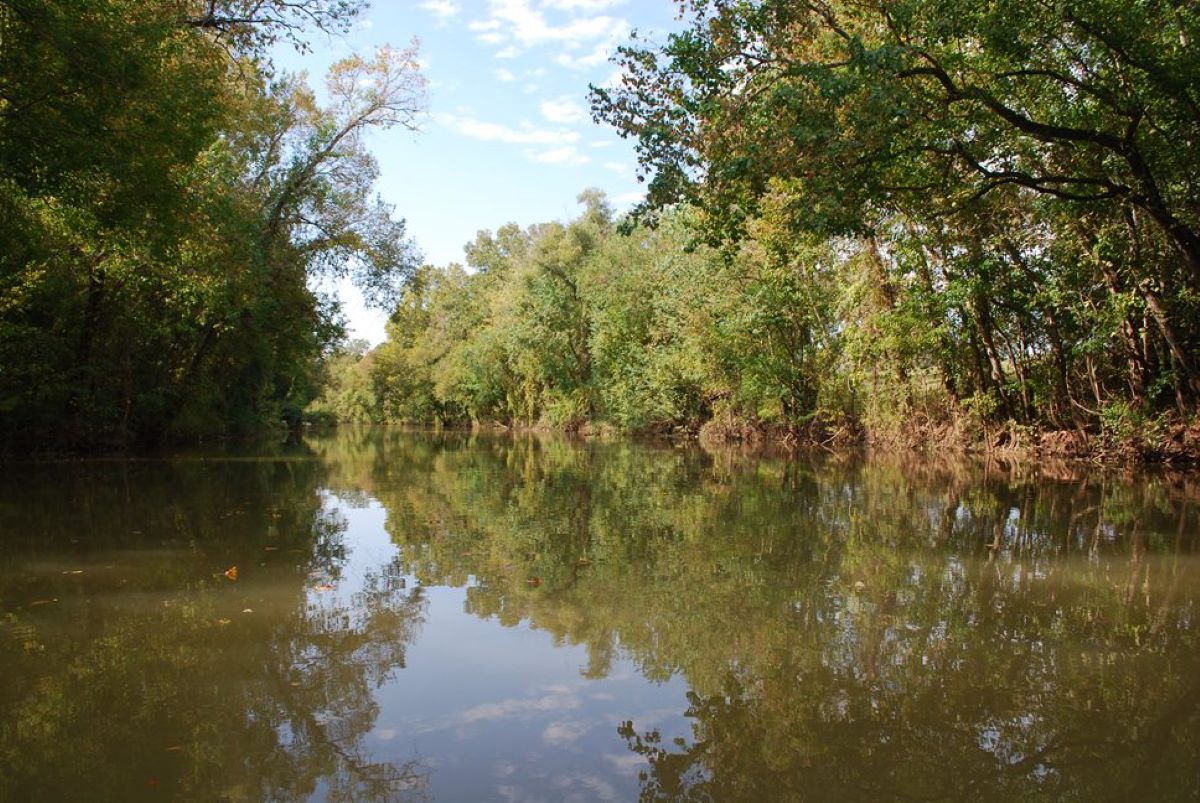Bayou Teche
Before railroads and highways, Bayou Teche served as an important transportation route deep into the fertile interior of south-central Louisiana.

Shane K. Bernard Collection
The Teche near Port Barre. Photo by Shane K. Bernard.
A historically significant Louisiana waterway, Bayou Teche runs about 125 miles long and passes through St. Landry, St. Martin, Iberia, and St. Mary Parishes. The Teche begins at Port Barre, where it stems from Bayou Courtableau. After passing through Breaux Bridge, St. Martinville, New Iberia, Franklin, and other bayou-side communities, it ends by flowing into the Lower Atchafalaya River at Patterson (some of its waters, however, reach the Gulf of Mexico via the modern-era Charenton Canal and Wax Lake Outlet). The Teche supported human habitation long before French and Spanish colonization and the coming of river-dependent industries that exploited enslaved Black workers. Those industries originally consisted of cattle ranches and indigo plantations but were replaced by the early 1800s by cotton plantations on the upper Teche and sugar plantations on the lower. Before railroads and highways the bayou served as an important transportation route deep into the fertile interior of south-central Louisiana.
The Teche formed about two thousand years ago, when it occupied earlier riverbeds left by the meandering Red River and, before that, the Mississippi River. Human occupation of the Teche region extends well before the bayou’s existence. Archaeological evidence indicates an Indigenous presence around thirteen thousand years ago, and at least forty-five hundred years ago, Indigenous peoples constructed a mound at Avery Island, only ten miles from the Teche. At the time of European colonialization, however, three Indigenous tribes lived along the bayou. These were the Opelousa, the Attakapas/Ishak, and the Chitimacha—only the latter still reside on the bayou today in sizable numbers (at Charenton). As early as 1746 the region’s earliest-known European pioneer, the Frenchman André Masse, brought the first enslaved persons of African descent to the waterway. In his wake came other European settlers, whose descendants would become part of the emerging Creole and Cajun populations. These settlers included French, Acadian, and Spanish settlers. However, in time, a notable Anglo-American enclave could be found along the Lower Teche, along with an Irish presence on the waterway’s aptly named Irish Bend. With the advent of large-scale cotton and sugar farming along the Teche came larger numbers of enslaved persons of African descent and a notable population of gens de couleur libres (free people of color). Later, after Emancipation, both groups experienced the oppression of Jim Crow, even as African Americans came to outnumber the region’s white population by 1880 and contributed significantly to the area’s rich cultural landscape.
Around 1830 steamboats began replacing old, hand-rowed flatboats that hauled cotton and sugar down the Teche to New Orleans. For about a century the new paddle-wheelers, often decorated with ornate fretwork, ruled the Teche, carrying agricultural products and human passengers into and out of the region. By the late 1800s, however, competition appeared in the form of Morgan’s Louisiana and Texas Railroad (later the Southern Pacific Railroad). Faster than river-borne transportation, railroads soon dominated shipping in the Teche area. Then, in the early 1900s, came automobiles, trucks, and the modern Teche-side highway—christened the Old Spanish Trail (a name chosen not for historical reasons but for publicity and tourism). These innovations further eroded the steamboat trade and the perceived value of the Teche as a vital transportation route. By the World War II era, the old riverboats (many converted to diesel in an attempt at modernization) had all but disappeared.
As a crucial artery for Louisiana’s sugar-based economy and a gateway into Louisiana’s interior, the Teche became a strategic target during the American Civil War. As one veteran recalled, “One side or the other was always running up or down the Teche with the other side in full chase after it.” Two notable battles occurred along the waterway: the Battle of Fort Bisland and the Battle of Irish Bend. Neither side in the conflict managed to keep a firm grasp on the region—explaining why the Teche endured three separate military invasions between 1863 and 1864. Widespread destruction resulted as both sides looted or destroyed the area’s valuable resources. A former enslaved person from New Iberia recalled, “The barns and houses had been burned. Vegetation had been trampled down. Chickens, mules, cattle, all had been driven off. There was not a living thing on the countryside. . . .”
Flooding and diseases like yellow fever had afflicted Teche-area residents both before and after the conflict. The last yellow fever outbreak in America occurred on the Teche in 1905, just as scientists learned to identify and target the disease’s source, the Aedes aegypti mosquito. Likewise, the last major flood on the Teche occurred in 1927, spurring federal and state governments to prevent future inundations by erecting water-control structures, such as levees, floodgates, locks, and drainage canals.
Today, Bayou Teche is a more serene waterway than during its heyday. Although push boats (similar to tug boats) and barges still ply the Teche, the waterway is now mainly used for recreation by boaters, fishermen, water skiers, and swimmers — despite signs warning the public that “Water Quality May Not be Suitable for Swimming.” These water-quality issues stem from several factors, including agricultural run-off (from sugarcane farming and livestock raising) and human waste (often traceable to outdated septic tank systems). However, nonprofits like the TECHE Project have organized in recent years “to make Bayou Teche whole again through action and education about its ecology, culture, and history.”
Despite disruptive changes imposed on the bayou since the early 1900s, Bayou Teche remains a source of beauty and inspiration, explaining why it has often appeared in poems, paintings, novels, short stories, and musical compositions, from Longfellow’s epic Evangeline to James Lee Burke’s bestselling works of detective fiction.
